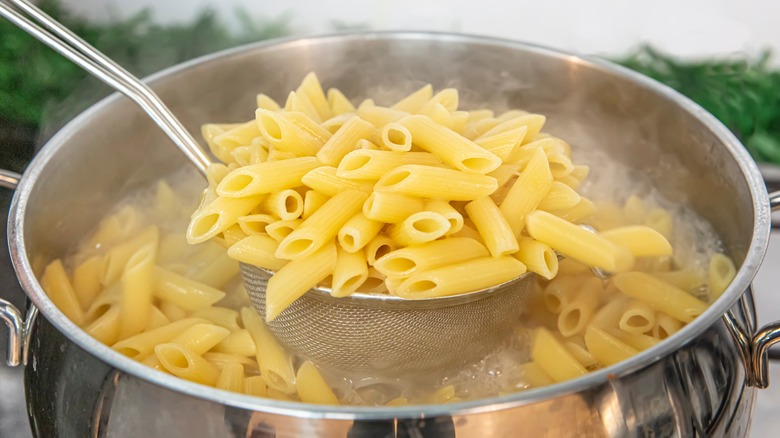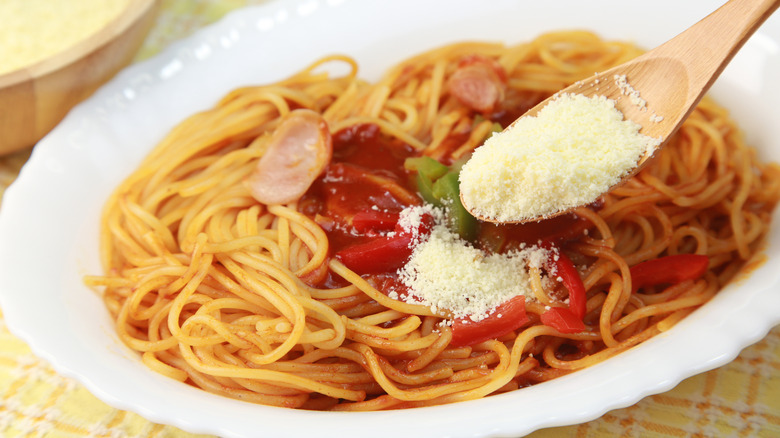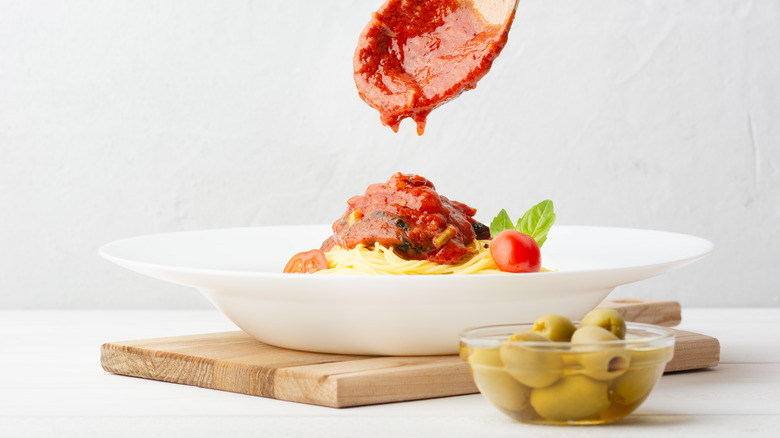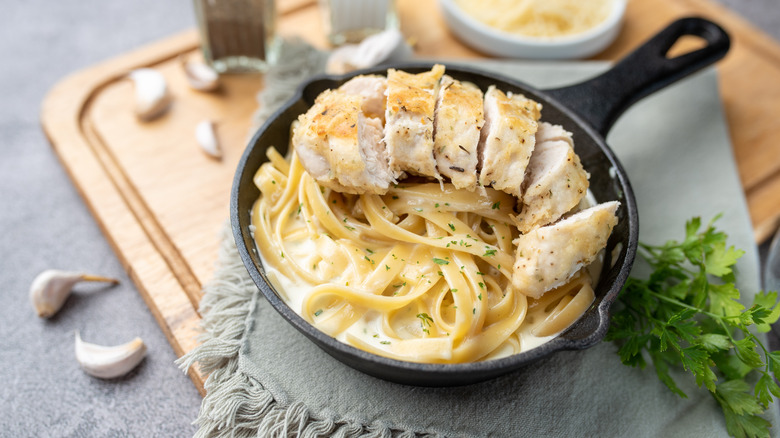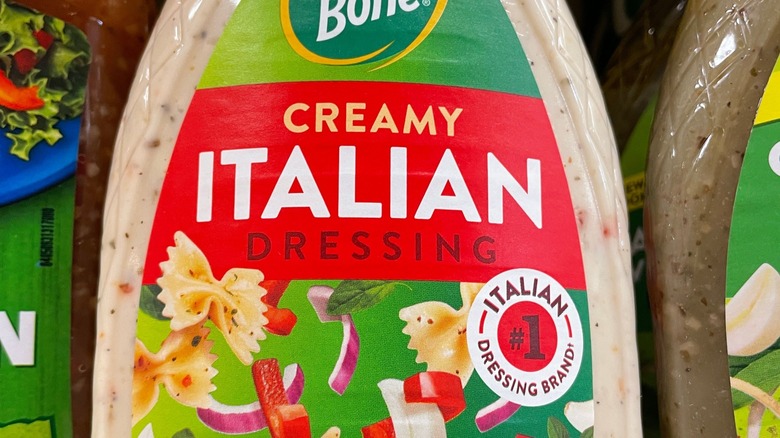14 Red Flags An Italian Restaurant Isn't Exactly Authentic
Americans love their Italian food. According to a YouGov study about favorite national cuisines, Italian food ranked at a high 84% for popularity, beating out other styles of food. What is it about Italian food that makes it so popular? If you love it, then the answer is obvious — it's delicious. Warm pasta is the ultimate comfort food. Most Italian dishes are simple with few ingredients, and sometimes simplicity feels like home. Plus, in the 1900s, America saw a massive wave of Italian immigrants. Many Americans have Italian blood in them or know someone who does. Cities boast "Little Italy" areas where people can get authentic Italian food like grandma used to make.
The Italian culture is passionate, full of music, art, romance, and great food created to be eaten together. If you aren't making your own Italian food, you likely enjoy finding your favorite pasta at Italian restaurants. In this article, we will discuss 14 red flags an Italian restaurant isn't exactly authentic. After all, if you're going out for Italian, you want true Italian.
The restaurant has unpleasant odors
When you walk into a restaurant, you should experience the tempting aromas of what's to come, not gross smells that make you want to leave. Bad odors in a restaurant could be caused by any number of issues, including unclean restrooms, counters and seating areas wiped down with dirty rags, or dirty floors underneath booths and tables. Spots like kitchen floor drains and trash bins that aren't washed out every day become foul smelling when food particles are stuck somewhere, or mold is growing.
Another area that isn't checked daily is kitchen ventilation. Poor ventilation in the kitchen allows foods like fish to leave their scent in the air. A restaurant's responsibility is to ensure foul odors are taken care of with proper cleaning. A good Italian restaurant pulls you in with the smells of fresh garlic, tomato sauces, and homemade pasta. If you smell anything but delicious food, it's likely a restaurant that places a low priority on a clean and spotless environment.
The staff knows nothing about Italian food
People who aren't Italian can certainly spend time in Italy and study the cuisine, then open a restaurant in America. However, if no one working at the restaurant seems interested in anything Italian, the food will likely not impress you. Each culture has its own style of dining, and in an Italian restaurant, you should experience at least a small bit of how Italians enjoy mealtime. It is never a time of feeling rushed. Your service at an Italian restaurant should reflect that. Foods are served in a leisurely fashion so one can take their time to enjoy each course. The menu should offer antipasti (appetizers), primi (pasta), secondi (meat), contorni (sides), and dolce (desserts).
Menus that are "Americanized" with no Italian words are often a sign that the food is Americanized as well. Also, pay attention to the knowledge of the staff. Not only should they understand the importance of not rushing you, but they should also easily answer your questions about the dishes. If you are wondering if something is truly Italian, a server must be ready to explain why it is or isn't.
The decor is worn out and dirty
Red checkered tablecloths in a small Italian restaurant are charming. Still, if they're worn out and dirty, there's a good chance the rest of the restaurant is, too. If there are no signs of pride in ownership, then what are the chances there is any pride in the quality of food?
A restaurant's décor is a reflection of its brand, and an establishment is wise to consider that. When a restaurant is updated or kept old in a charming way, it gives you a good idea of what the meal will be like. Fake flowers on the table that are coated in dust should make customers concerned about the kitchen's cleanliness and the food's authenticity. When what is being served is important, everything is important.
The atmosphere is one of the reasons people go out to eat. It's not all about the food. An authentic Italian restaurant should take you to Italy in every way — from the architecture to the décor and from the servers to the food.
They offer other cuisine
This may be obvious, but an Italian restaurant should serve Italian food. If you see hamburgers and other American fares on the menu, you aren't about to eat authentic Italian food. Italians are proud of their heritage and their incredible cuisine that is loved around the world. Serving food that isn't from Italy at an authentic Italian restaurant simply wouldn't happen. It might, however, occur at a restaurant that feels it must share plenty of options because its main cuisine doesn't impress.
You want to eat somewhere where people talk about homemade pasta and delicate sauces for days after they've been there. Restaurants with an extensive menu often indicate that the chefs aren't specialized.While they might be able to whip up a tasty bolognese, that doesn't mean they know how to make it authentically. They need to be just as good at making a burger as a quesadilla as a lasagna, so the focus isn't there. Plus, extensive menus often mean there are a lot of ingredients in the kitchen, indicating you might not be getting served frozen food that was reheated. You wouldn't find that in an authentic Italian restaurant.
The place is empty
Sometimes you're in the mood for a high-energy place as you dine out, and other times you may want some peace and quiet. Still, an empty restaurant may not be the best choice for a relaxing night out. If a restaurant has been around for a while and is still empty, you may want to go elsewhere.
Unfortunately, sometimes a good restaurant sits empty because of difficulties in other areas than the food. For example, restaurants often fail due to poor management. That could mean that there wasn't enough investment in good marketing or not enough capital to begin with, making it impossible to keep up with the cost of running a high-quality restaurant. Still, many restaurants don't make it because the food and service are subpar. If you've noticed a restaurant you plan to visit seems to always be empty, you can look for reviews. If you find that it's just not good, you don't have to waste your time.
No seasonal food
There are a lot of delicious foods we can eat year-round; however, there are some that are best in season. Excellent Italian food boasts fresh tomatoes, herbs, and other veggies. It's not always possible to cook with what is currently in season, especially if you live in a colder climate. Still, an authentic Italian restaurant strives to use the freshest ingredients possible and avoid dishes that are out of season. If the restaurant menu never changes or claims fresh zucchini all year long, something isn't right.
Seasonal foods simply taste better. If you've ever compared a garden-fresh tomato to one shipped to your grocery store out of season, you understand. The other benefit of seasonal eating is more variety in your diet. When you don't eat seasonally, you get stuck in a rut with eating the same foods over and over. Variation helps you get a healthy rotation of vitamins, proteins, and fats. It's a good sign when a restaurant cares about that.
Pizza is far from Italian
There are many styles of pizza, and Americans argue about which is best. However, when in an Italian restaurant, the pizza should be some of the best you've ever had. If it looks and tastes like it was pulled from the freezer, that's bad news. So, how do you know if it's authentic? It starts with ingredients.
An authentic Italian pizza is simple. It doesn't need a lot of extra spices and toppings since the excellent dough and sauce speak for themselves. The dough is homemade and never a "pan-style" pizza. The Italians expertly knead their pizza dough, let it rise for many hours, and then gently roll it into a lovely, thin crust. Next, the sauce should smell like tomatoes and not be bothered with too many spices. It's usually just fresh tomatoes, basil, and olive oil, mixed together and not cooked. Last, your authentic Italian pizza should have fresh and high-quality cheese. Cheap cheese is certainly tempting in the restaurant biz, but it's a mistake. Flavor is everything.
No homemade pasta options
Homemade pasta is a rare treat, and unless you make it at home, an excellent Italian restaurant is a place to experience it. Julia Helton, a chef and restaurant consultant tells Insider, "Nicer Italian restaurants have a person on staff who only makes pasta. There is nothing like freshly made pasta; it makes going back to the dried stuff really difficult." You likely know how to boil dried pasta. Going out to eat is an opportunity to experience authentic food you don't make regularly at home.
A good Italian restaurant uses its own pasta recipes to create a lasting impression on its guests. If it makes its noodles in-house, you will know because either the menu will specify that or the waiter will tell you directly. When in a good Italian restaurant, if you're deciding between two dishes and only one points out that it involves homemade pasta, go with the homemade one.
The meatballs are ridiculously large
Bigger isn't always better. One of the biggest mistakes people make when making meatballs, and a tell-tale sign of an unauthentic Italian restaurant is rolling them too big. An authentic Italian restaurant won't offer the "one pound meatball" on their menu. Truthfully, Italians don't eat spaghetti and meatballs together. That can be a bit shocking to hear. Have you been lied to your entire life? Most people just don't know that Italians seldom put meat on top of their pasta. There may be a little bit of crumbled meat in a sauce, such as Bolognese, but never balls of meat placed on top of spaghetti.
Still, if you love your meatballs, it's okay to indulge. However, in an authentic Italian restaurant, the meatballs are served separately from the spaghetti and are not large. If the restaurant serves a giant meatball as a meal, they might as well serve meatloaf.
They serve bread before the meal
The Italians make wonderful bread and are known for about 350 different styles across Italy. Some of the most popular are focaccia, ciabatta, and grissino. As delicious as Italian bread is, in Italy, bread is to be enjoyed with the meal, not as an appetizer. That's the opposite of what many Americanized Italian restaurants offer. Often, a bread basket is placed on the table of a restaurant to comfort rumbling stomachs as customers wait for food.
Authentic Italian restaurants bring bread with the meal, so you don't get filled up on carbs before the main course. And by the way, Italians don't dip their bread in oil. That's also an American invention. In Italy, bread is usually saved until a plate is almost empty and used to enjoy the leftover sauces. If you're seeking an authentic Italian restaurant, the fact that they bring bread at the right or wrong time could indicate what the rest of the meal will be like.
They only offer powdered cheese
Who doesn't love Parmesan sprinkled on their pasta? There's certainly nothing wrong with cheese on pasta, and the Italians love cheese as much as the Americans do. However, powdered Parmesan cheese is an American creation. It's convenient and has a long shelf life, but it's likely not real Parmesan.
Cucina by Elena explains that Parmigiano (Parmesan is the Americanized version) cheese is quite regulated in Italy. The crust of a block of real Parmigiano cheese has the words "Parmigiano Reggiano" dotted into it. The Italians take pride in their Parmigiano and don't allow counterfeits. There is no regulation of "Parmesan" cheese in the U.S., which means you might be getting additives rather than the real deal. Wood pulp, Swiss, and other cheaper cheeses have been found in the powdered containers, some of which sometimes carried zero Parmesan. Excellent Italian restaurants serve real Parmigiano, and it is grated at the table upon your request.
The sauce is poured on top of the pasta
Authentic Italian pasta dishes aren't served with the sauce ladled on top of the pasta as many of us do at home. You may find the ladling method convenient at times, especially when someone in the family doesn't want the sauce mixed in. Still, authentic Italian pasta always has the sauce mixed in with the noodles rather than spooned on top.
When making Italian dishes, the sauce and pasta are made separately, and then when the pasta is cooked and drained, it is poured into the pot of sauce. Finally, the pasta is tossed with the sauce and then served. This method allows even sauce distribution, and it coats each piece of pasta so the flavors are melded together in every bite.
A red flag that an Italian restaurant isn't authentic is when they pour the sauce on top of the pasta and don't mix it. It's also a red flag if they offer a pasta selection and a separate sauce selection, then simply pour whichever sauce you want on top of whichever pasta you choose.
Too much chicken
Chicken with pasta does not exist in Italy. Sorry — that chicken Alfredo you've been ordering at your favorite Italian restaurant is not legit. Italians don't put any meat on top of their pasta. It's always a separate course (secondi on the menu), except in a few sauces where crumbled meat is used.
An authentic Italian restaurant doesn't cave to Americanized ideas of Italian food. Pasta is the first course after an appetizer, and meat is the course that follows after. Chicken is eaten in Italy, but it's not cut up and placed on top of pasta. That means your chicken Parmigiano which is often served on top of a plate of spaghetti, is not authentic. For a true Italian experience, seek out restaurants that create a menu exactly as they would in Italy. This is wisely planned, so the flavors of each course are enjoyed. If a restaurant insists on mixing them all together, perhaps it's because one course can't stand on its own.
Dishes are labeled 'Italian style'
Italy has 20 different regions, and a good Italian restaurant cooks food from its favorite region. There is no such thing as one "Italian style" food. Have you ever been in the grocery store and read "Italian style" on a label? These are common on salad dressings or Italian bread. You might even have some in your kitchen right now.
Just as there isn't one American style of food, there isn't one Italian style. Be leery of Italian restaurants that advertise Italian-style food or offer Italian-style options on their menu. Instead, authentic Italian restaurants explain on their menu, website, or through their servers what region of Italy the food is from. Once that is clear, you can expect the cuisine to be specific to that area. For example, a Northern Italian restaurant serves more rice and polenta than a southern style, and a southern style Italian restaurant is influenced by Mediterranean dishes.








